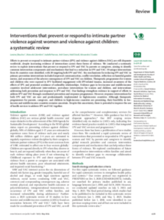Efforts to prevent or respond to intimate partner violence (IPV) and violence against children (VAC) are still disparate worldwide, despite increasing evidence of intersections across these forms of violence. The authors conducted a systematic review to explore interventions that prevent or respond to IPV and VAC by parents or caregivers, aiming to identify common intervention components and mechanisms that lead to a reduction in IPV and VAC.
30 unique interventions from 16 countries were identified, with 20 targeting both IPV and VAC. Key mechanisms for reducing IPV and VAC in primary prevention interventions included improved communication, conflict resolution, reflection on harmful gender norms, and awareness of the adverse consequences of IPV and VAC on children. Therapeutic programmes for women and children who were exposed to IPV facilitated engagement with IPV-related trauma, increased awareness of the effects of IPV, and promoted avoidance of unhealthy relationships.
Evidence gaps in low-income and middle-income countries involved adolescent interventions, post-abuse interventions for women and children, and interventions addressing both prevention and response to IPV and VAC. Their findings strengthen evidence in support of efforts to address IPV and VAC through coordinated prevention and response programmes. However, response interventions for both IPV and VAC are rare and predominantly implemented in high-income countries.
Although therapeutic programmes for parents, caregivers, and children in high-income countries are promising, their feasibility in lowincome and middle-income countries remains uncertain. Despite this uncertainty, there is potential to improve the use of health services to address IPV and VAC together.

